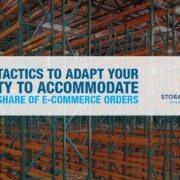In 2017, e-commerce orders represented about 10.4% of total retail sales, according to a study conducted by eMarketer. In 2021, that number jumped to 18.1%. That same study estimates that by 2023, more than 22% of total retail sales are facilitated online. With that massive jump in a relatively short amount of time, warehouses, distribution centers, and fulfillment centers across the supply chain are reacting and adapting their practices to accommodate this rising share of e-commerce orders.
Traditionally, warehouses have long been configured for pallet-in and pallet-out for shipping orders. However, both e-commerce orders and direct-to-consumer fulfillment require a completely different picking and packing process. These processes are more expensive for fulfillment centers that don’t have systems to handle e-commerce orders because they need a lot more human capital and labor cost.
While facilities are making changes to adapt to the e-commerce and direct-to-consumer explosion, some are left behind, wondering what the best course of action is for their operations. While each operation is unique, businesses can take a few actionable steps to adapt their existing facility to accommodate an increased level of e-commerce.
Tactic 1: Create a Forward Pick Area
According to Warehouse Science, a forward pick (or fast-pick) area is “[an area] from which it is most efficient to pick, but which must be restocked from a reserve or overflow or bulk storage area.” Essentially, you treat your static storage media as “reserve storage” and move specific products to a storage area, from which most of your orders are picked. This forward pick area needs more frequent replenishment than the reserve storage, but the flip side is that orders can be fulfilled more quickly.
The products stored in this area need to be the appropriate SKUs & stored in the proper storage medium based on the cubic movement of the SKU. If you decide to use the most ordered SKUs, they need to be stored in a larger storage medium to avoid excessive restocking of the forward pick area which could cost some of the efficiency you gained by creating this dedicated storage area.
Typically, the best practice is to use a warehouse execution system (WES) or workflow optimization software to determine the best SKUs to minimize your labor costs. Our team of experts has decades of experience matching the right software for your unique needs with our agnostic approach to vendors and partners for our clients.
Tactic 2: Evaluate New Storage and Picking Methods
Another way to adapt to changes caused by an increased level of e-commerce orders is to add systems and capabilities that allow for batch and zone picking. Vertical lift modules are a goods-to-person solution that can take small-sized products, store them in a high-density, low-footprint storage system and deliver them to pickers, who then assemble orders on a cart or take them to a shipping area.
Zone picking is good for multi-line orders because it reduces travel time for pickers, and autonomous mobile robots (AMRs) are another goods-to-person solution to assist in these efforts. At a high level, AMRs can take the walking/travel element out of the picking process by moving the products from storage to a given location, be it a packing station, a conveyor system, or just to an employee, who can then pick the items & package them together.
To a more considerable degree, automated storage and retrieval systems (AS/RS) or other automation solutions that support goods to person picking can also reduce travel time and create more dense storage. However, these will generally come in at a higher initial cost than the AMR solution, which can be integrated without affecting your existing infrastructure.
Tactic 3: Automate Packing Processes
E-commerce and direct-to-consumer orders usually are not pallet-sized orders; they are parcel-sized orders. So, when a facility is accustomed to shipping pallets, how do you adopt best practices for these smaller orders? If the order is a single-line order, you could probably have the shipping team place a label on the item & ship it. However, what happens with multi-line orders?
Automated packaging solutions exist that can accommodate a wide variety of consolidating and shipping multi-line orders. They can also accommodate potential requirements like polybags, dunnage, airbags, Styrofoam peanuts, and various other materials to keep packages safe from damage. By automating these processes – from right-sizing packages to physically loading trucks – you save a sizeable amount of labor costs that were not needed in a pre-e-commerce world.
Where Do You Go From Here?
If you have seen an increase in each or case picking, then give us a call. Whether you are adapting your current facility to account for increased levels of e-commerce or your manufacturing partners are considering a more direct-to-consumer strategy, having the capability to meet your customers’ expectations on fulfillment time and accuracy is essential. We would recommend starting at the design stage and finding a partner that understands how to optimize material flow and storage media. Of course, Storage Solutions has a team of experts on staff that can assist with these challenges.
Contact us today, and we can talk through your challenges, identify some quick wins, and formulate a plan of action. We may suggest dense storage, automation, or some other process-related plan built for your business. Depending on your needs, we may help without a site visit, but we may suggest one as well.
Either way, we should talk. Give us a call today!


